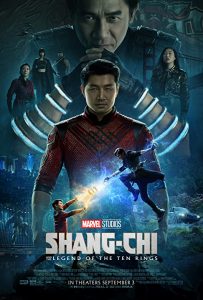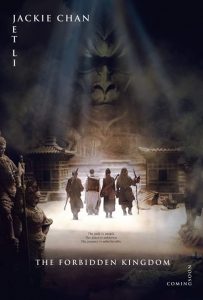 I’m not here for the idea of making links to a bunch of previous movies, but some quick and uncertain mental math tells me that Shang-Chi and the Legend of the Ten Rings relies on four previous and mostly unconnected MCU movies[1] to explain its backstory. (Six if you care about the Blip.) None of these movies include Shang-Chi in a credited role, or even acknowledge his existence. And I mean… I’ve read within a small rounding error of 100% of 25 years’ worth of Marvel comics, so I’m obviously here for it, but that is noticeable weight of continuity to labor under, you know?
I’m not here for the idea of making links to a bunch of previous movies, but some quick and uncertain mental math tells me that Shang-Chi and the Legend of the Ten Rings relies on four previous and mostly unconnected MCU movies[1] to explain its backstory. (Six if you care about the Blip.) None of these movies include Shang-Chi in a credited role, or even acknowledge his existence. And I mean… I’ve read within a small rounding error of 100% of 25 years’ worth of Marvel comics, so I’m obviously here for it, but that is noticeable weight of continuity to labor under, you know?
Anyway, the plot is the plot and yes I want to see it again, but nobody is interested in an MCU spoiler review, not even two weeks late like this one basically is. But between a pre-verbal child and Covid, it’s harder to get to the theater on time than it used to be, you know?
What I am interested in is the things that were cribbed from the comics, with which I have a more than passing familiarity[2]. Master of Kung Fu (as a comic) focused on two things. First, both in importance and chronology, a generation-later retelling of the old Fu Manchu stories with a lot of those characters still in play. Fu Manchu is as yellow-perily as ever, and the British spies who oppose him are likewise as clichedly British. Only, now he (Fu) has a daughter set up as his heir apparent[3], and a finely-honed, kung fu assassin-trained son who has turned against him for being, y’know, evil and whatnot. And second, once the comic wasn’t all Fu all the time, it also focused on being a British spy agency story in which Shang-Chi traveled the world with James Bond’s nephew[4] doing superhero-adjacent spy stuff and living out a spy-girlfriend relationship to a Fleetwood Mac soundtrack.
The movie only focuses on the first of those, except obviously not using Fu Manchu and instead pulling in the so-called Mandarin and his ten rings, by way of the terrorist organization we’ve seen before, all the way back in the very first MCU movie. But then it also pulls in a lot of Iron Fist’s mythology, what with an extra-dimensional kung fu city that you can only get to every so many time intervals, unless you know secret ways; and also, their kung fu is magical wuxia kung fu. Sad to be the guy who played Danny Rand in the Netflix show, but zero percent sad to see the expert martial artist not be some random white dude.
My point, if indeed I had one, is that if you were going to cram a mildly problematic Iron Man villain named the Mandarin together with Marvel’s two martial arts characters, this is pretty much the best way to have done so. And furthermore, if you weren’t going to cram those together into one story but instead spread them out among three, well, probably you should cram them together instead.
[1] And a “Marvel One-Shot” that I’d seen before as a Blu-ray extra, which was released on Disney+ two weeks before Shang-Chi’s release date, to minimal fanfare.
[2] While that is a verified fresh statement, I honestly didn’t remember most of these things until the end of the movie. I spent like 2 hours saying to myself “I don’t remember Shang-Chi having a sister,” for example, until suddenly I was all “oh yeah” instead.
[3] Not that he intends to ever do anything so gauche or pedestrian as dying, but still: contingencies.
[4] Among others, but the more important point is that I’m serious about that.
 True confessions time: I never really got deeply into kung fu movies. I mean, I watched Bruce Lee movies when I was a kid, because they were just there for the taking on weekend afternoons on the UHF channels, and how could you not watch them? And it was awesome to see all the ass-kickery as Bruce (or whoever) made his way through an army of lesser men and then took out some bad guy or other in an ultimate confrontation. But I never really got into the storyline, just the chopsocky. And then later Jackie Chan appeared with his death-defying stunts of pure awesome but the same kind of storyline. And then Jet Li and his hidden snapper brought wuxia to my attention, with its emphasis on magical realism and Chinese folklore, and finally there were plots that I could get into, but I knew there was a ton of background to it that I somehow managed to miss on those long ago weekend afternoons, and I’ve felt kind of out of the loop ever since. It’s very tragic.
True confessions time: I never really got deeply into kung fu movies. I mean, I watched Bruce Lee movies when I was a kid, because they were just there for the taking on weekend afternoons on the UHF channels, and how could you not watch them? And it was awesome to see all the ass-kickery as Bruce (or whoever) made his way through an army of lesser men and then took out some bad guy or other in an ultimate confrontation. But I never really got into the storyline, just the chopsocky. And then later Jackie Chan appeared with his death-defying stunts of pure awesome but the same kind of storyline. And then Jet Li and his hidden snapper brought wuxia to my attention, with its emphasis on magical realism and Chinese folklore, and finally there were plots that I could get into, but I knew there was a ton of background to it that I somehow managed to miss on those long ago weekend afternoons, and I’ve felt kind of out of the loop ever since. It’s very tragic.